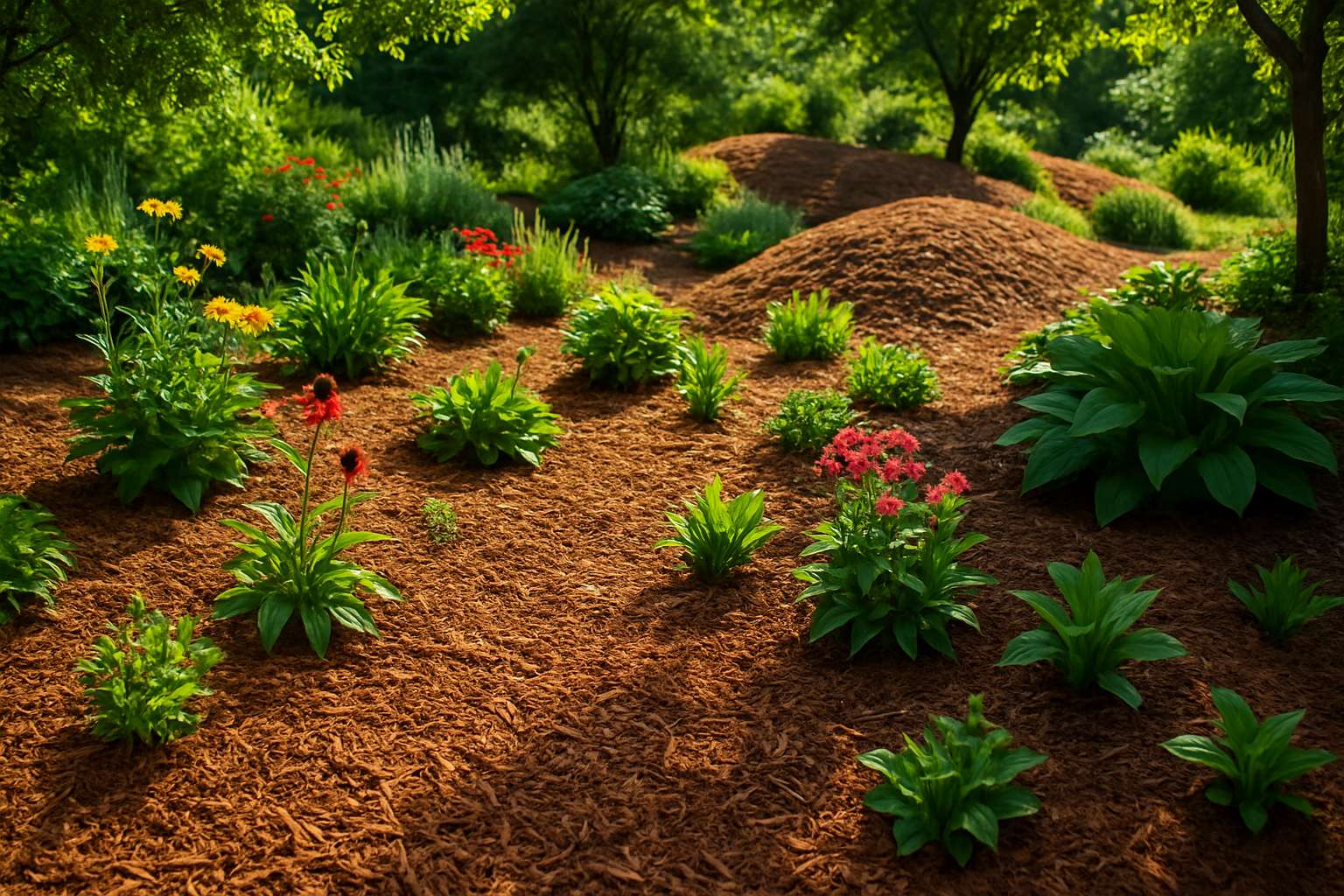
TL;DR: Organic mulch does more than improve aesthetics. Field research shows it performs seven simultaneous functions: water retention (29-70% increase), weed suppression (up to 90%), temperature regulation (18-degree reduction), soil enrichment (15-25% more microbial activity), erosion prevention, natural pest deterrence, and visual appeal.
Core Benefits:
-
Increases soil moisture retention by 29 to 70%
-
Reduces weed emergence by up to 90% through light blocking
-
Regulates soil temperature swings by up to 18 degrees
-
Boosts microbial activity 15 to 25% for healthier soil
-
Prevents erosion while attracting beneficial earthworms
How Does Mulch Improve Water Retention?
Mulch creates a physical barrier between the soil and the atmosphere. The barrier alters the evaporation equation in ways you'll notice at the hose.
Long-term field studies show mulch rates increased available water capacity by 18 to 35%. Soil moisture retention jumped from 29 to 70% in organic mulch applications. These aren't lab conditions. These are working gardens under real weather patterns.
The mechanism is straightforward. Mulch blocks solar radiation, driving surface evaporation. Soil temperatures stay cooler. Moisture stays available to root systems longer.
What this means for you: You water less often. Plants access hydration more consistently. The math shifts in your favour.
Bottom line: Mulch cuts watering frequency because it prevents moisture loss at the soil surface.
Why Does Mulch Stop Weeds So Effectively?
Weeds need light to germinate. Mulch removes the variable from the equation.
Research shows thick mulch layers reduce weed emergence by up to 90%. The mechanism isn't chemical. It's purely a physical obstruction.
Application depth matters:
-
Four to eight inches: effective control of annual weeds throughout the growing season
-
Four-inch depth: maintains greater than 60% control even in late summer
The barrier prevents light from reaching dormant seeds. Without light, germination fails. Without germination, you're not pulling weeds in July.
What this means for you: Changed maintenance schedules. Reduced chemical interventions. More time for cultivation instead of weed management.
Bottom line: Thick mulch blocks sunlight, stopping weed seeds from germinating before they become a problem.
How Does Mulch Regulate Soil Temperature?
Soil temperature fluctuations stress plant root systems. Mulch dampens those swings in ways your plants will respond to.
An MSU study documented that organic mulch regulates soil temperatures by as much as 18 degrees at midday. Forest leaf debris and wood chips kept average temperatures cool with minimum-to-maximum fluctuations within 5 to 9 degrees during peak summer stress.
The insulation works in both directions:
-
Winter: maintains soil temperatures 7 to 10 degrees warmer than unmulched areas
-
Summer: creates microclimates up to 12 degrees cooler during peak heat
Root zones stay stable. Plants avoid thermal shock. Growth continues under conditions causing stress dormancy otherwise.
Bottom line: Mulch insulates roots from extreme temperature swings, reducing plant stress year-round.
What Happens When Mulch Decomposes?
Organic mulches don't stay static. They break down. The decomposition feeds soil ecosystems in ways synthetic fertilizers don't.
As mulch decomposes, it releases nitrogen, phosphorus, potassium, and micronutrients. These become available gradually, matching plant uptake rates better than synthetic applications. The decomposition also increases cation exchange capacity, helping soil retain nutrients more effectively.
Microbial benefits:
-
15 to 25% increase in microbial activity compared to bare ground
-
Supports beneficial organisms like nitrifying bacteria and mycorrhizal fungi
-
Suppresses harmful pathogens
The result? Living soil. Not dirt with added fertilizer, but a functioning ecosystem sustaining itself.
Bottom line: Decomposing mulch feeds soil microbes and releases nutrients slowly, building long-term soil health.
How Does Mulch Prevent Soil Erosion?
Heavy rainfall moves topsoil. Mulch anchors it in place.
The protective layer prevents raindrops from directly hitting soil surfaces. This minimizes compaction and surface crusting. Water infiltrates instead of running off. Soil structure stays intact.
For sloped landscapes, this matters more than you might think. Erosion removes your most fertile topsoil, the layer with the highest organic matter and microbial activity. Mulch preserves the capital.
The barrier also attracts earthworms. They aerate soil naturally while adding nutrient-rich castings. The combination of reduced erosion and increased biological activity improves drainage and soil tilth over time.
Bottom line: Mulch protects topsoil from rain impact and runoff, especially critical on slopes.
Does Mulch Help With Pest Control?
Certain mulches contain compounds repelling insects. Cedar and cypress release natural oils deterring common garden pests without chemical intervention.
Pine needles offer a different advantage. They contain allelopathic compounds that suppress weed seedlings while contributing nitrogen as they decompose. Contrary to common belief, pine needle mulch doesn't alter soil pH over time.
These aren't replacement-level pest control methods. But they add another layer of protection to integrated management strategies.
Bottom line: Some mulch types naturally repel pests and suppress weeds through chemical compounds.
What About Aesthetic Benefits?
Visual appeal matters for property value and personal satisfaction. Mulch delivers both form and function.
A well-mulched bed creates defined edges and uniform colour. It signals intentional garden management. Unlike purely decorative interventions, mulch provides measurable returns on every function outlined above.
You're not choosing between appearance and performance. You're getting both from a single application.
Bottom line: Mulch looks good while delivering measurable functional benefits.
The Compound Effect
Here's where things get interesting.
Each benefit reinforces the others. Better moisture retention supports microbial activity. Healthier soil structure improves water infiltration. Reduced weeds mean less competition for nutrients. Temperature stability extends growing seasons.
The research reveals mulch as a keystone intervention. One action triggers cascading improvements across multiple garden systems.
We often look for complex solutions to gardening challenges. Sometimes the evidence points to simple practices with profound impacts. Mulch falls into this category. The data supports what experienced gardeners have observed: properly applied organic mulch changes how gardens function at fundamental levels.
Frequently Asked Questions
How thick should I apply mulch?
Apply 4 to 8 inches for effective weed control and moisture retention. Four inches provides 60% weed control even in late summer. Deeper layers offer better results.
Does mulch attract pests?
Some mulches, like cedar and cypress, actually repel pests through natural oils. Pine needles contain compounds that suppress weeds while adding nitrogen. Choose your mulch type based on your pest concerns.
Will mulch change my soil pH?
Pine needle mulch won't alter soil pH despite common belief. Most organic mulches have minimal pH impact as they decompose slowly over time.
How often should I replace mulch?
Replace when the depth falls below 4 inches or when decomposition reduces effectiveness. Organic mulches break down at different rates depending on type and climate.
What's the best mulch for water retention?
Organic mulches like wood chips and forest leaf debris perform well. Studies show 29 to 70% moisture retention increases across various organic mulch types.
Does mulch work in winter?
Yes. Winter mulch applications maintain soil temperatures 7 to 10 degrees warmer than unmulched areas, protecting roots from freeze damage.
Will mulch prevent all weeds?
Thick layers reduce weed emergence by up to 90%, but not 100%. Physical obstruction blocks light needed for germination, making weed control much easier.
How does mulch improve soil over time?
Decomposing mulch releases nutrients gradually, increases cation exchange capacity, and boosts microbial activity by 15 to 25%. This creates self-sustaining soil ecosystems.
Key Takeaways
-
Mulch increases soil moisture retention by 29 to 70%, reducing watering frequency
-
Four to eight inches of organic mulch blocks light and reduces weed emergence by up to 90%
-
Temperature regulation of up to 18 degrees protects roots from thermal stress year-round
-
Decomposing mulch boosts microbial activity 15 to 25% while releasing nutrients gradually
-
Mulch prevents erosion, attracts earthworms, and improves soil structure over time
-
Each benefit compounds with others, creating cascading improvements across garden systems
-
Properly applied organic mulch transforms garden function at fundamental levels
The science isn't hidden. It's rarely compiled in one place. Now you have the evidence. The application decisions are yours.

